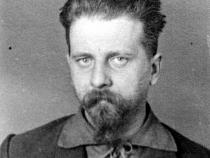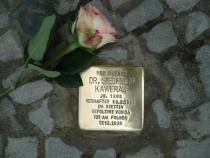Location
Bonhoefferufer 18
Historical name
Charlottenburg
District
Charlottenburg
Stone was laid
09 April 2009
Born
08 December 1886 in Berlin
Death as a result of maltreatment
17 December 1936 in Berlin
The atmosphere in 1919 and 1920 was like springtime for the people, pervaded with possibility and hope. The youth, women and workers storming the bastions of the old society.
Siegfried Kawerau: Self portrait, undated
Siegfried Kawerau came from a family of teachers and studied history, German and Latin. In 1913, he too became a secondary school teacher in Landsberg an der Warthe. In 1915, he was called up to the army. After a traumatic experience in Verdun, he was dismissed from the army and declared no longer fit for military service. In 1917, he applied to be transferred to a school for girls because he considered girls' education to be particularly important. Two years later, the family moved to Charlottenburg which was still an independent town. Around this time, Kawerau left the Protestant Church for political reasons, saying it was “like a widow grieving for Wilhelm II. He became a member of the SPD and founded the Bund Entschiedener Schulreformer (League of decisive school reformers) with Paul Oestreich. He campaigned for a school uniting work, life and education, for independence from school fees and free provision of schoolbooks and equipment, and spoke out against denominational schools and schools for specific social classes. In 1927, he became the headmaster of the Köllnisches Gymnasium and Kaempfschule schools. These were experimental schools which combined seven years of primary schooling with six years’ secondary education in preparation for the Abitur leaving certificate and also taught methods of democratic self-government. Never again war events were held there annually. In 1933, Kawerau was suspended as headmaster. In early March that year, he applied for early retirement to avoid clashes with the Nazis at school. The family moved to their summer house in Pustchow on the Baltic coast. He was arrested there on 19.3.1933 and sent to prison in Stettin, where he was subjected to severe physical abuse. He was released after 11 weeks, partly thanks to the campaigning of foreign friends. He was dismissed from his teaching positions on 1.9.1933 on political grounds. The four Kawerau children emigrated in 1933 and 1934. Siegfried Kawerau never recovered from the physical and mental trauma he suffered during detention but died after months of serious illness. In 1995, the district of Charlottenburg decided to install a plaque in his memory at the house at Bonhoeffer Ufer 18 where Siegfried Kawerau had lived. However, the owner of the building refused to give his permission.
Siegfried Kawerau was a city councillor from 1925 – 1930; Constituency 7 Charlottenburg (SPD)
Siegfried Kawerau: Self portrait, undated
Siegfried Kawerau came from a family of teachers and studied history, German and Latin. In 1913, he too became a secondary school teacher in Landsberg an der Warthe. In 1915, he was called up to the army. After a traumatic experience in Verdun, he was dismissed from the army and declared no longer fit for military service. In 1917, he applied to be transferred to a school for girls because he considered girls' education to be particularly important. Two years later, the family moved to Charlottenburg which was still an independent town. Around this time, Kawerau left the Protestant Church for political reasons, saying it was “like a widow grieving for Wilhelm II. He became a member of the SPD and founded the Bund Entschiedener Schulreformer (League of decisive school reformers) with Paul Oestreich. He campaigned for a school uniting work, life and education, for independence from school fees and free provision of schoolbooks and equipment, and spoke out against denominational schools and schools for specific social classes. In 1927, he became the headmaster of the Köllnisches Gymnasium and Kaempfschule schools. These were experimental schools which combined seven years of primary schooling with six years’ secondary education in preparation for the Abitur leaving certificate and also taught methods of democratic self-government. Never again war events were held there annually. In 1933, Kawerau was suspended as headmaster. In early March that year, he applied for early retirement to avoid clashes with the Nazis at school. The family moved to their summer house in Pustchow on the Baltic coast. He was arrested there on 19.3.1933 and sent to prison in Stettin, where he was subjected to severe physical abuse. He was released after 11 weeks, partly thanks to the campaigning of foreign friends. He was dismissed from his teaching positions on 1.9.1933 on political grounds. The four Kawerau children emigrated in 1933 and 1934. Siegfried Kawerau never recovered from the physical and mental trauma he suffered during detention but died after months of serious illness. In 1995, the district of Charlottenburg decided to install a plaque in his memory at the house at Bonhoeffer Ufer 18 where Siegfried Kawerau had lived. However, the owner of the building refused to give his permission.
Siegfried Kawerau was a city councillor from 1925 – 1930; Constituency 7 Charlottenburg (SPD)




